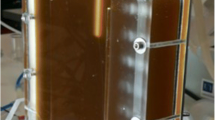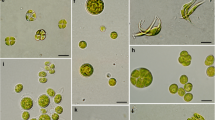Abstract
Nine strains of diatoms (representing four species) were screened for their ability to produce eicosapentaenoic acid (EPA) when cultured heterotrophically on glucose. Four strains were able to produce EPA heterotrophically using glucose as its carbon and energy source. Of the four,Nitzschia laevis was the best EPA producer, yielding 0.017 g g−1 dry cell weight.N. laevis was the only species tested which synthesised more EPA heterotrophically than photosynthetically. This study shows thatN. laevis is a potential source of EPA production using heterotrophic culture conditions with glucose as the carbon and energy substrate.
Similar content being viewed by others
References
Behrens PW Hoeksama KL, Arnett MSC, Heubner TA, Rutten JM, Kyle DJ (1989) Eicosapentaenoic acid from microalgae. In Demain AL, Somkuti GA, Hunter-Ceve JC, Rossmoore HW (eds), Novel Microbial Products for Medicine and Agriculture. Elsevier Science Publishers, Amsterdam: 253–259.
Borek C (1994) ω3 fatty acids as anti-carcinogens: Cellular and molecular studies. World Rev. Nutr. Diet. 76: 66–69.
Chen F, Johns MR (1995) A strategy for high cell density culture of heterotrophic microalgae with inhibitory substrates. J. appl. Phycol. 7: 43–46.
Chu SP (1942) The influence of the mineral composition of the medium on the growth of planktonic algae. I. Methods and culture media. J. Ecol. 30: 284–325.
Cohen Z, Norman HA, Heimer YM (1995) Microalgae as a source of ω3 fatty acids. World Rev. Nutr. Diet. 77: 1–31.
Day JD, Edwards AP, Rodgers GA (1991) Development of an industrial-scale process for the heterotrophic production of a micro-algal mollusc feed. Bioresource Technol. 38: 245–249.
Dickson LG, Galloway RA, Patterson GW (1969) Environmentally induced changes in the fatty acids of Chlorella. Plant Physiol. 44: 1413–1416.
Javanmardian M, Palsson BO (1991) High density photoautotrophic cultures: design, construction and operation of a novel photobioreactor system. Biotechnnol. Bioengng 38: 1182–1189.
Johns MR (1994) Heterotrophic culture of microalgae. In Phang SM, Kun LY, Borowitzka MA, Whitton BA (eds), Algal Biotechnology in the Asia-Pacific Region. Univ. Malaya, Kuala Lumpur: 150–154.
Lewin JC (1953) Heterotrophy in diatoms. J. gen. Microbiol. 9: 305–313.
Lewin JC, Lewin RA (1960) Auxotrophy and heterotrophy in marine littoral diatoms. Can. J. Microbiol. 6: 127–134.
Lewin J, Hellebust JA (1970) Heterotrophic nutrition of the marine pennate diatom,Cylindrotheca fusiformis. Can. J. Microbiol. 16: 1123–1129.
Lewin J, Hellebust JA (1978) Utilisation of glutamate and glucose for heterotrophic growth by the marine pennate diatomNitzschia laevis. Mar. Biol. 47: 1–7.
Norday A, Hansen JB (1994) ω3 fatty acids and cardiovascular risk factors. World Rev. Nutr. Diet. 76: 51–54.
Opute FI (1974) Lipid and fatty acid composition of diatoms. J. exp. Botany 25 (87): 23–835.
Orcutt DM, Patterson GW (1975) Sterol, fatty acid and elemental composition of diatoms grown in chemically defined media. Comp. Biochem. Physiol. 50B: 579–583.
Popp-Snijders C, Blonk MC (1995) Omega-3 fatty acids in adipose tissue of obese patients with non-insulin-dependent diabetes mellitus reflect long-term dietary intake of eicosapentaenoic and docosahexaenoic acid. Am. J. Clin. Nutr. 61: 360–365.
Radwan SS, Mangold HK (1980) Biochemistry of lipids in plant cell cultures. Adv. Biochem. Eng. 16: 109–133.
Reis A, Gouveia L, Veloso V, Fernandes HL, Empis JA, Novais JM (1994) Eicosapentaenoic acid production by the microalgaPhaeodactylum tricomutum using continuous culture. In Alberghina L, Frontali L, Sensi P (eds), ECB6: Proc. 6th European Congress on Biotechnol. Elsevier Science B.V : 1121–1124.
Reitz RC, Moore GS (1972) Effects of changes in the major carbon source on the fatty acids ofEuglena gracilis. Lipids 7: 217–220.
Richmond A (1992) Open systems for the mass production of photoautotrophic microalgae outdoors: physiological principles. J. appl. Phycol. 4: 281–286.
Robinson DR, Xu LL, Knoell CT, Tateno S, Guo M, Colvin RB, Olesiak W, Urakaze M, Sugiyama E, Auron PE, Yeh ETH, Austen KF, Sperling RI (1994) Alleviation of autoimmune disease by ω3 fatty acids. World Rev. Nutr. Diet. 76: 95–102.
Roessler PG (1990) Environmental control of glycerolipid metabolism in microalgae: Commercial implications and future research directions. J. Phycol. 26: 393–399.
Suen Y, Hubbard JS, Holzer G, Tornabene TG (1987) Total lipid production of the green alga Nannochloropsis sp. QII under different nitrogen regimes. J. Phycol. 23: 289–296.
Tan CK, Johns MR (1991) Fatty acid production by heterotrophicChlorella saccharophila. Hydrobiologia 215: 13–19.
Varela G, Perez M, Ruiz-Roso B (1990) Changes in the quantitative and qualitative composition if fat from fish, due to seasonality and industrial and culinary processing. In Somogyi JC, Hotzel D (eds) Marine Foods. Bibl. Nutr. Dieta. Basel, Karger 40: 104–109.
Yongmanitchai W Ward OP (1991) Growth of and omega-3 fatty acid production byPhaeodactylum tricomutum under different culture conditions. Appl. envir. Microbiol. 57 (2): 419–425.
Author information
Authors and Affiliations
Additional information
Author for correspondence
Rights and permissions
About this article
Cite this article
Tan, C.K., Johns, M.R. Screening of diatoms for heterotrophic eicosapentaenoic acid production. J Appl Phycol 8, 59–64 (1996). https://doi.org/10.1007/BF02186223
Received:
Accepted:
Issue Date:
DOI: https://doi.org/10.1007/BF02186223




